
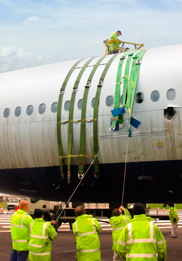
Airlines need to have an effective plan in place to quickly recover an airplane following an incident. Boeing has a team of experienced airplane recovery experts that advise airlines on how to prepare and execute effective airplane recovery. The goal is to minimize the time required to perform a safe and successful recovery operation with no secondary damage.
By Jerry Paluszek, Lead Principal Engineer, Maintenance Tooling and Facilities/Airplane Recovery, Maintenance and Ground Operation Systems
Boeing provides recovery resources and services from documents and tools to comprehensive airplane recovery services.
Quick and decisive actions are essential for effective airplane recovery. Boeing can help operators develop recovery plans and offers on-site airplane recovery assistance. In roughly 80 percent of recoveries the airplane involved has left a hard surface during inclement weather.
This article explains Boeing’s role in airplane recovery, including designing recovery options during airplane development, special recovery tools, airplane recovery documents, ongoing customer support, and complete incident recovery and repair services.
PLANNING FOR AIRPLANE RECOVERY DURING NEW AIRPLANE DEVELOPMENT
During airplane development, Boeing designs tool commonality and a number of airplane recovery options into the airplane to help ensure future airplane recoveries occur with no or minimal secondary damage.
Boeing establishes airplane recovery requirements in five key areas during airplane development:
- Weight and center of gravity (CG) management. Boeing uses CG calculations to help ensure that the airplane’s design will allow for safe defueling, fuel transfer, cargo removal, and component removal.
- Emergency defueling with no power on. Boeing has developed special tools and methods for suction and gravity defueling. For example, Boeing plans to incorporate a defueling fitting for the 787 using the airplane’s main and override jettison pumps. A portable external power control unit is available for defueling all Boeing models.
- Lifting/shoring. Drawing on past experiences, Boeing analyzes and establishes the best lifting scenarios and then designs lifting locations on the airplane that are best suited to support lifting in those scenarios. Boeing determines the loads required at those locations to adequately lift the airplane to eliminate or minimize secondary damage.
- Tethering. Normally tethering is necessary during lifting operations, especially during inclement weather. Boeing establishes areas on the airplane that provide the best locations for tethering, monitoring all loads applied to the airplane structure (see fig. 1).
- Transporting. Boeing determines the best interface locations and provides supporting techniques and methods to transport the airplane.
Figure 1: Tethering on the 777
Boeing provides operators with detailed diagrams showing locations for tethering to reduce or eliminate the chances of secondary damage.
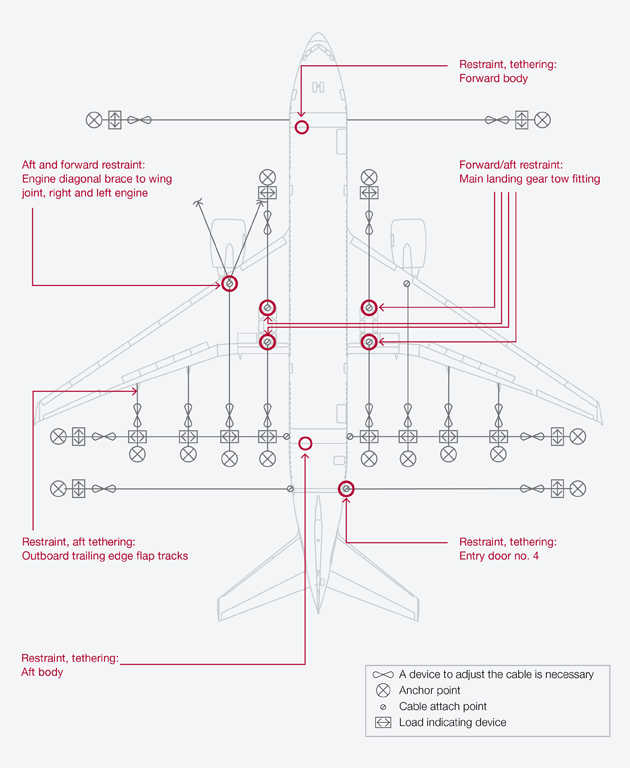
SPECIAL RECOVERY TOOLS
Boeing has designed special tools and equipment to support the lifting, stabilizing, moving, support, and general requirements associated with an airplane recovery operation. These tools include both single- and twin-aisle fuselage lifting/tethering slings and a main landing gear hoist assembly designed for the 777 (see figs. 2, 3, and 4).
Additional resources are also available from the International Airlines Technical Pool. Through the organization, member airlines can obtain recovery kits which include the basic equipment needed for a successful recovery.
Figure 2: Twin-aisle fuselage sling for lifting
Boeing sling assembly in lifting position. Only one sling position is used for primary lifting (forward or aft). The second sling is positioned for stabilization only — not to be used for full airplane lift.
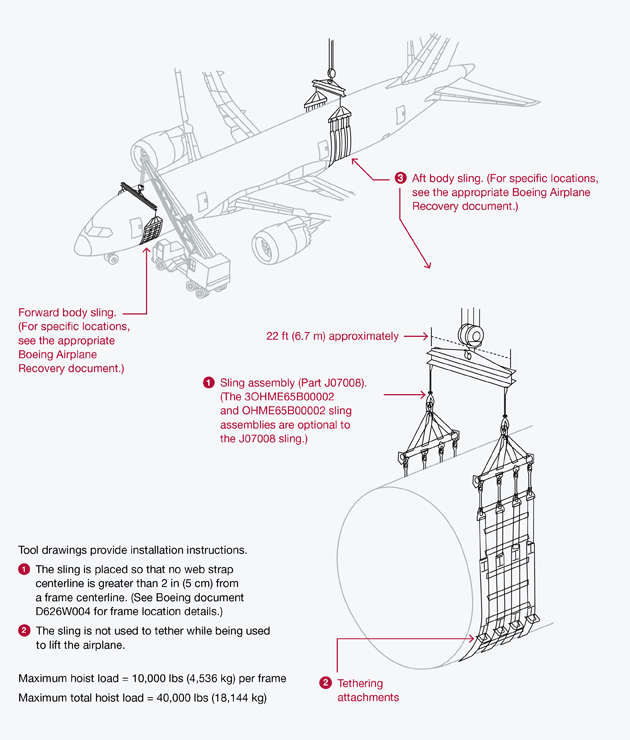
Figure 3: Fuselage sling for tethering
Boeing sling assembly in tethering position.
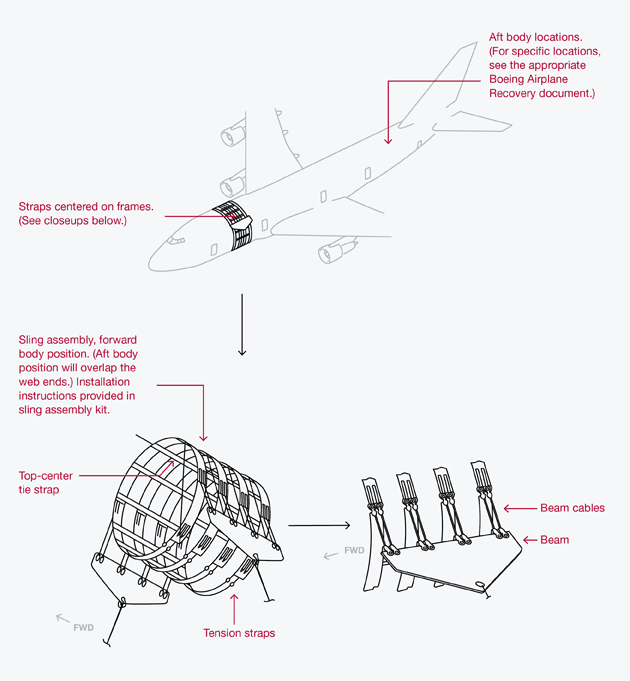
Figure 4: Sling for lifting 777 from main landing gear
Boeing has designed a special hoist assembly that can be used to lift a 777 with intact main landing gear.
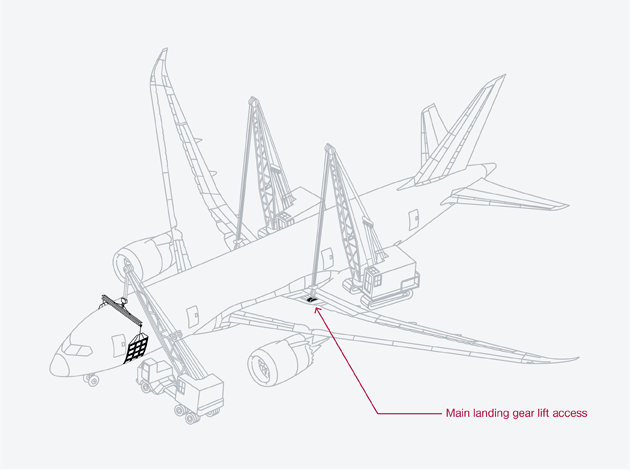
AIRPLANE RECOVERY DOCUMENTS
Boeing creates airplane recovery documents specific to each model that specify appropriate recovery tools and methods and address environmental concerns related to airplane recovery. These documents — which are revised for new airplane model derivatives and on an as-required basis for current models — are provided to the airline 90 days prior to its first airplane delivery.
Boeing airplane recovery documents comply with the Air Transport Association (ATA) 100/2100 (digital) specification, which details information such as weight and CG management, preparation, weight reduction, leveling and lifting, moving the airplane, post-recovery, and special recovery tools. The 787 will conform to the new ATA iSpec 2200.
Boeing provides airplane recovery documents for each airplane type:
- 707, 727, 737
- Next-Generation 737
- 747
- 757
- 767
- 777
- MD-80
- DC-10-10
- DC-10-30/40
- MD-11
- MD-90
- 717
- 787
- 747-8
ONGOING CUSTOMER SUPPORT
Boeing is committed to keeping airline customers apprised of new technologies in airplane recovery equipment and methods. To this end, Boeing coordinates with equipment suppliers to learn about new products and their suitability for airplane recovery operations. Airplane recovery procedures and new equipment listings are updated in the recovery documents after their effectiveness has been established.
Airlines can also take advantage of educational opportunities, including airplane recovery exercises. In addition, Boeing provides continuous and ongoing support for special tools and equipment design, information and consultation, technical services support, airplane recovery familiarization training, and on-site airplane recovery technical services.
RECOVERY SERVICES
When requested by an airline, Boeing provides on-site comprehensive, integrated assistance to recover a disabled or damaged Boeing airplane wherever in the world it is located. Requests for such assistance are submitted to Boeing Field Service representatives.
Boeing recovery support includes diagnosis, repairs, logistics, parts procurement, certification issues, and other services as dictated by the specific recovery.
Boeing’s goal is to assist the airline operator to return the airplane to service with as little disruption to the airline’s schedules as possible and to streamline the operator’s communication with all departments of Boeing, as well as with applicable regulatory agencies.
Boeing offers:
- On-site technical support to assist in the recovery of severely disabled or damaged airplane.
- On-site consultation on appropriate airplane recovery equipment and methods.
- On-site assistance in the use of airplane recovery documents that provide critical information such as lifting, tethering, transporting, and other data required to recover Boeing airplanes.
- Training on aircraft recovery and assisting airlines in establishing their own airplane recovery teams.
Boeing also assists airlines with:
- Damage survey of airplanes on ground.
- Damage repair.
SUMMARY
Airplane recovery preparedness is essential to the successful operation of every airline. Boeing assists customers with a variety of airplane recovery resources and services, ranging from airplane recovery documents and tools to comprehensive airplane recovery services.
For more information, contact Jerry Paluszek.

